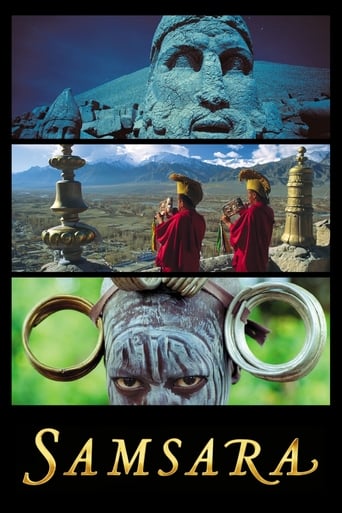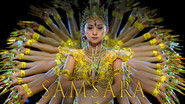Christopher Culver
In 1993, filmmakers Ron Fricke and Mark Magidson presented a deeply moving portrait of features universal to all human societies, warned of ecological collapse, and depicted how technology was changing our lives in BARAKA. Shot on 70mm film, this was one of the most visually impressive films ever made, and its lack of any dialogue or narration allowed viewers to engage in their own individual reflections about the panorama on the screen. Two decades later, the team returned with SAMSARA, a sequel that wasn't really necessary.One reason that SAMSARA is not very good is that it often seems a shot-for-shot repeat of BARAKA. The filmmakers revisit many of the same locations (such as Thai prostitutes, a chicken-processing plant, home appliance factories, landfill gleaners). Again Buddhism, the Ka'aba and high church Christianity are depicted, but because the film does not go on to any other religions than what was on BARAKA, these rituals feel this time like cheap exoticism instead of unquenchable anthropological curiosity. SAMSARA also lacks the dramatic arc of BARAKA, coming across as a random succession of images instead of the journey from sacredness to horror and back that we found in its predecessor.That is not to say that SAMSARA is completely without interest. There is an astonishing clip of performance artist Olivier de Sagaza, and the freakish Dubai landscape is depicting in a detail that few (even those who have been there) have seen. SAMSARA is all in all a darker film, and while depictions of the wreckage of Katrina, a Wyoming family that are proud to own an arsenal of guns, and a wounded veteran may fail to really shock viewers in the West who have already been exposed to such images for years, scenes of garish funerals in Nigeria and Indonesian men making the rounds in a sulphur mine (even though they know it is killing them) are stirring and memorable. Of course the visuals are rich, and in Bluray format on my HD projector the film is just as stunningly detailed as its predecessor.However, SAMSARA lacks enough new things to say, it surprisingly doesn't offer continual rewards on rewatching, and just by the fact that it exists out there it potentially dilutes the impact of BARAKA, once a singular film. I was entertained enough to give this a 3-star rating, but I would still recommend BARAKA, and even for those who have seen and loved BARAKA, I would not recommend moving on to this film.
zurmalik-296-458388
An amazing documentary almost as majestic as "Voyager Golden Record" covering a very large aspect of this word today. It actually takes you to the scenery. The music absorbs you in it up to a level that you don't know you were watching it on screen. You start feeling like you are dreaming it. The locations chosen are mesmerizing. And religions have been depicted so greatly with so little of the information but conveys what religion is all about very comprehensively.Now Spoiler Part: It shows a very well presented scene from Makkah Soudi Arabia. Kaaba on the screen. The largest of the religious gatherings, all steps happening in unison. And sound of most famous of Azaans(Call for prayer) so perfectly blended into the rest of the music that I almost didn't catch it the first time. But watching again I noticed azaan could have no music in background and still it would have made it a perfect scene, or perhaps a more attractive and likable one.
Felonious-Punk
Immense! This movie shows us things we're familiar with and things we have never even imagined, and yet it all comes from somewhere in our home, on our planet, within our environment. Framed by Buddhist philosophy and art, we have a god's-eye-view of all continents, all classes, so many cultures and vastly different terrains. We see the endless desert- scape, we see Cairo, the United States, China, Tibet, indigenous peoples of South America, the architecture of Rome, the worshippers of Mecca. We see various trades, the wounded, the dead, families, contrasting political and social agendas. We are left with a feeling of bittersweet grandiosity, the way that Buddhism leaves its adherents. Pain exists, we may never get rid of it. Maybe violence cannot solve violence. Maybe the path of progress is a lot slower than most of us think, maybe the only solution is to take on this weighty all-encompassing compassion that this movie offers up, and pray that it spreads by example and because it is the most virtuous and inevitable way. That's the magic of this movie, that it does not look down on anyone, it seeks to document everyone as they would be documented, and yet there is editorializing, however subtle it is: that we all have the nobility of consciousness, and we are all each as consequential as a fleck of sand upon the Sahara.
grantss
Brilliant, but difficult to explain why. No plot, no acting (well, except for one scene, but I'll come to that). So, it's a documentary then? Yes, sort of, but there is no narration, nor captions, nor even tags to let you know what or where in the world you are looking at.In essence, it's a visual documentary on the modern world. Initially it just seems like National Geographic without any commentary: beautiful scenes of temples, nature and places you might want to go as a tourist. However, 100 minutes of random places and things could be boring after a while. Just when you start to think that might well be the case, themes start to emerge: nature, buildings, opulence vs poverty, guns/military, livestock. Pretty much everyday things, and how they are connected.It is basically a 100-minute stream-of-consciousness exercise, using amazing, totally natural visual imagery (ie no CGI). Enjoy it for where it takes your mind, or just for the images and the drama of everyday life.Only negative note is the one scene that isn't candid: a performance artist. Very pretentious and pointless and prevents this movie from being perfect.


 AD
AD



